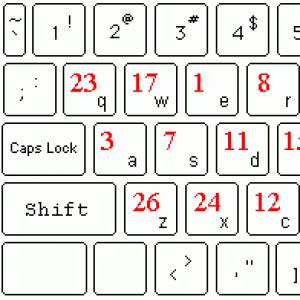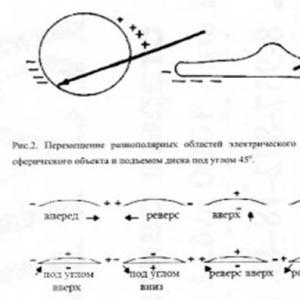The fraction of an element in a substance. How to calculate the mass fraction of a substance
Knowing the chemical formula, you can calculate the mass fraction of chemical elements in a substance. element in substances is denoted by the Greek. the letter "omega" - ω E / V and is calculated by the formula:
where k is the number of atoms of this element in the molecule.
What is the mass fraction of hydrogen and oxygen in water (H 2 O)?
Solution:
M r (H 2 O) \u003d 2 * A r (H) + 1 * A r (O) \u003d 2 * 1 + 1 * 16 \u003d 18
2) Calculate the mass fraction of hydrogen in water:
3) Calculate the mass fraction of oxygen in water. Since the composition of water includes atoms of only two chemical elements, the mass fraction of oxygen will be equal to:

Rice. 1. Formulation of the solution of problem 1
Calculate the mass fraction of elements in the substance H 3 PO 4.
1) Calculate the relative molecular weight of the substance:
M r (H 3 RO 4) \u003d 3 * A r (H) + 1 * A r (P) + 4 * A r (O) \u003d 3 * 1 + 1 * 31 + 4 * 16 \u003d 98
2) We calculate the mass fraction of hydrogen in the substance:
3) Calculate the mass fraction of phosphorus in the substance:
4) Calculate the mass fraction of oxygen in the substance:
1. Collection of tasks and exercises in chemistry: 8th grade: to the textbook by P.A. Orzhekovsky and others. "Chemistry, Grade 8" / P.A. Orzhekovsky, N.A. Titov, F.F. Hegel. - M.: AST: Astrel, 2006.
2. Ushakova O.V. Chemistry workbook: 8th grade: to the textbook by P.A. Orzhekovsky and others. “Chemistry. Grade 8” / O.V. Ushakova, P.I. Bespalov, P.A. Orzhekovsky; under. ed. prof. P.A. Orzhekovsky - M .: AST: Astrel: Profizdat, 2006. (p. 34-36)
3. Chemistry: 8th grade: textbook. for general institutions / P.A. Orzhekovsky, L.M. Meshcheryakova, L.S. Pontak. M.: AST: Astrel, 2005.(§15)
4. Encyclopedia for children. Volume 17. Chemistry / Chapter. edited by V.A. Volodin, leading. scientific ed. I. Leenson. - M.: Avanta +, 2003.
1. A single collection of digital educational resources ().
2. Electronic version of the journal "Chemistry and Life" ().
4. Video lesson on the topic "Mass fraction of a chemical element in a substance" ().
Homework
1. p.78 No. 2 from the textbook "Chemistry: 8th grade" (P.A. Orzhekovsky, L.M. Meshcheryakova, L.S. Pontak. M .: AST: Astrel, 2005).
2. With. 34-36 №№ 3.5 from Workbook in chemistry: 8th grade: to the textbook by P.A. Orzhekovsky and others. “Chemistry. Grade 8” / O.V. Ushakova, P.I. Bespalov, P.A. Orzhekovsky; under. ed. prof. P.A. Orzhekovsky - M.: AST: Astrel: Profizdat, 2006.
What is a mass fraction? For example, the mass fraction of a chemical element is the ratio of the mass of the element to the mass of the entire substance. The mass fraction can be expressed both as a percentage and fractions.
Where can the mass fraction be used?
Here are some of the directions:
Determination of the elementary composition of a complex chemical
Finding the mass of an element by the mass of a complex substance
For calculations, the Molar Mass of a Substance calculator is used online with extended data that can be seen if you use an XMPP query.
The calculation of similar tasks that are indicated above, when using this page, becomes even easier, more convenient and more accurate. Speaking of accuracy. In school textbooks, for some reason, the molar masses of elements are rounded to integer values, which is quite useful for solving school problems, although in fact the molar masses of each chemical element are periodically adjusted.
Our calculator does not strive to show high accuracy (above 5 decimal places), although this is not difficult. For the most part, those atomic masses of elements that use the calculator are sufficient to solve the tasks set for determining the mass fractions of elements
But for those pedants :) who care about accuracy, I would like to recommend the link Atomic Weights and Isotopic Compositions for All Elements in which all chemical elements, their relative atomic masses, as well as the masses of all isotopes of each element.
That's all I would like to say. Now we will consider specific tasks and how to solve them. Note that although they are all heterogeneous, they are inherently based on the molar mass of a substance and the mass fractions of elements in that substance.
At the beginning of autumn 2017, I added another calculator Mole fractions of matter and the number of atoms, which will help solve problems for the mass of a pure substance in a complex substance, the number of moles in a substance and in each element, as well as the number of atoms / molecules in a substance.
Examples
Calculate the mass fraction of elements in copper sulfate CuSO 4
The request is very simple, just write the formula and get the result, which will be our answer
As already mentioned in school textbooks, there are rather rough values, so do not be surprised if the answers paper books You will see Cu = 40%, O = 40%, S = 20%. This is, let's say, "side effects" of simplification school material, for students. For real problems, our answer (the bot's answer) is naturally more accurate.
If it was about what to express in fractions and not percentages, then we divide the percentages of each of the elements by 100 and get the answer in fractions.
How much sodium is contained in 10 tons of cryolin Na3?
We introduce the cryolin formula and get the following data
From the data obtained, we see that 209.9412 amounts of a substance contain 68.96931 amounts of sodium.
Whether we measure it in grams, in kilograms or tons, nothing changes for the ratio.
Now it remains to build another correspondence where we have 10 tons of the original substance and an unknown amount of sodium
This is a typical proportion. Of course, you can use the Calculation of Proportions and Ratios bot, but this proportion is so simple that we will do it with handles.
209.9412 is to 10 (tons) as 68.96391 is to an unknown number.
Thus, the amount of sodium (in tons) in cryolin will be 68.96391*10/209.9412=3.2849154906231 tons of sodium.
Again, for the school, sometimes it will be necessary to round up to an integer the mass content of elements in a substance, but the answer is actually not very different from the previous one.
69*10/210=3.285714
Accuracy to hundredths is the same.
Calculate how much oxygen is contained in 50 tons of calcium phosphate Ca3(PO4)2?
Mass fractions of a given substance are as follows
The same proportion as in the previous problem 310.18272 applies to 50 (tons) as well as 127.9952 to the unknown value
answer 20.63 tons of oxygen is in a given mass of matter.
If we add an exclamation mark to the formula, telling us that the task is school (rough rounding of atomic masses to integers is used), then we get the following answer:
The proportion will be like this
310 refers to 50 (tons) as well as 128 to an unknown quantity. And the answer
20.64 tons
Something like this:)
Good luck with your calculations!!
What is the meaning of the concept of "mass fraction"?
The mass fraction is measured as a percentage or simply in tenths. A little higher, we talked about the classic definition, which can be found in reference books, encyclopedias or school chemistry textbooks. But to understand the essence of what has been said is not so simple. So, suppose we have 500 g of some complex substance. Complex in this case means that it is not homogeneous in composition. By and large, any substances that we use are complex, even simple table salt, the formula of which is NaCl, that is, it consists of sodium and chlorine molecules. If we continue the reasoning on the example of table salt, then we can assume that 500 grams of salt contains 400 grams of sodium. Then its mass fraction will be 80% or 0.8.
Why does a gardener need this?
I think you already know the answer to this question. The preparation of all kinds of solutions, mixtures, etc. is an integral part of the economic activity of any gardener. In the form of solutions, fertilizers, various nutrient mixtures, as well as other preparations are used, for example, growth stimulants "Epin", "Kornevin", etc. In addition, it is often necessary to mix dry substances, such as cement, sand and other components, or ordinary garden soil with purchased substrate. At the same time, the recommended concentration of these agents and preparations in prepared solutions or mixtures in most instructions is given in mass fractions.
Thus, knowing how to calculate the mass fraction of an element in a substance will help the summer resident to correctly prepare the necessary solution of fertilizer or nutrient mixture, and this, in turn, will necessarily affect the future harvest.
Calculation algorithm
So, the mass fraction of an individual component is the ratio of its mass to the total mass of a solution or substance. If the result obtained needs to be converted into a percentage, then it must be multiplied by 100. Thus, the formula for calculating the mass fraction can be written as follows:
W = Mass of substance / Mass of solution
W = (Mass of substance / Mass of solution) x 100%.
An example of determining the mass fraction
Suppose we have a solution, for the preparation of which 5 g of NaCl was added to 100 ml of water, and now it is necessary to calculate the concentration of table salt, that is, its mass fraction. We know the mass of the substance, and the mass of the resulting solution is the sum of two masses - salt and water and equals 105 g. Thus, we divide 5 g by 105 g, multiply the result by 100 and get the desired value of 4.7%. This is the concentration that the saline solution will have.
More practical task
In practice, the summer resident often has to deal with tasks of a different kind. For example, it is necessary to prepare an aqueous solution of a fertilizer, the concentration of which by weight should be 10%. In order to accurately observe the recommended proportions, you need to determine what amount of the substance will be needed and in what volume of water it will need to be dissolved.
The solution of the problem starts in the reverse order. First, you should divide the mass fraction expressed as a percentage by 100. As a result, we get W \u003d 0.1 - this is the mass fraction of the substance in units. Now let's denote the amount of substance as x, and the final mass of the solution - M. In this case, the last value is made up of two terms - the mass of water and the mass of fertilizer. That is, M = Mv + x. Thus, we get a simple equation:
W = x / (Mv + x)
Solving it for x, we get:
x \u003d W x Mv / (1 - W)
Substituting the available data, we obtain the following dependence:
x \u003d 0.1 x Mv / 0.9
Thus, if we take 1 liter (that is, 1000 g) of water to prepare the solution, then approximately 111-112 g of fertilizer will be needed to prepare the solution of the desired concentration.
Solving problems with dilution or addition
Suppose we have 10 liters (10,000 g) of a ready-made aqueous solution with a concentration in it of a certain substance W1 = 30% or 0.3. How much water will need to be added to it so that the concentration drops to W2 = 15% or 0.15? In this case, the formula will help:
Mv \u003d (W1x M1 / W2) - M1
Substituting the initial data, we get that the amount of added water should be:
Mv \u003d (0.3 x 10,000 / 0.15) - 10,000 \u003d 10,000 g
That is, you need to add the same 10 liters.
Now imagine the inverse problem - there are 10 liters of an aqueous solution (M1 = 10,000 g) with a concentration of W1 = 10% or 0.1. It is necessary to obtain a solution with a mass fraction of fertilizer W2 = 20% or 0.2. How much starting material should be added? To do this, you need to use the formula:
x \u003d M1 x (W2 - W1) / (1 - W2)
Substituting the original value, we get x \u003d 1 125 g.
Thus, knowledge of the simplest basics of school chemistry will help the gardener to properly prepare fertilizer solutions, nutrient substrates from several elements, or mixtures for construction work.
The concept of "share" is probably already familiar to you.
For example, the piece of watermelon shown in the figure is one quarter of the whole watermelon, that is, its share is 1/4 or 25%.
To better understand what a mass fraction is, imagine a kilogram of sweets (1000g) that a mother bought for her three children. From this kilogram younger child got half of all the sweets (unfair of course!). The eldest - only 200g, and the average - 300g.
This means that the mass fraction of sweets in the youngest child will be half, or 1/2 or 50%. The middle child will have 30% and the older child will have 20%. It should be emphasized that the mass fraction can be a dimensionless value (quarter, half, third, 1/5, 1/6, etc.), and can be measured as a percentage (%). When solving computational problems, it is better to convert the mass fraction into a dimensionless quantity.
Mass fraction of a substance in solution

Any solution consists of a solvent and a solute. Water is the most common inorganic solvent. Alcohol, acetone, diethyl ether, etc. can be organic solvents. If a solvent is not specified in the problem statement, the solution is considered to be aqueous.
The mass fraction of a solute is calculated by the formula:
$\omega_\text(v-v)=\dfrac(m_\text(v-v))(m_\text(p-ra))(\cdot 100\%)$
Consider examples of problem solving.
How many grams of sugar and water should be taken to prepare 150 g of a 10% sugar solution?
Solution
m(r-ra)=150g
$\omega$(sugar)=10%=0.1
m(sugar)=?
m(sugar) = $\omega\textrm((sugar)) \cdot m(p-pa) = 0.1 \cdot 150 \textrm(r) = 15 \textrm(r)$
m (water) \u003d m (solution) - m (sugar) \u003d 150g - 15g \u003d 135g.
ANSWER: you need to take 15g of sugar and 135g of water.
Solution with a volume of 350 ml. and a density of 1.142 g/ml contains 28 g of sodium chloride. Find the mass fraction of salt in the solution.
Solution
V(solution)=350 ml.
$\rho$(solution)=1.142 g/ml
$\omega(NaCl)$=?
m(r-ra) =V(r-ra) $\cdot \rho$(r-ra)=350 ml $\cdot$ 1.142 g/ml=400g
$\omega(NaCl)=\dfrac(m(NaCl))(m\textrm((p-ra)))=\dfrac(28\textrm(r)) (400\textrm(r)) = 0.07 $=7%
ANSWER: mass fraction of sodium chloride $\omega(NaCl)$=7%
MASS FRACTION OF AN ELEMENT IN A MOLECULE
The formula of a chemical, for example $H_2SO_4$, carries a lot of important information. It denotes either a single molecule of a substance, which is characterized by a relative atomic mass, or 1 mole of a substance, which is characterized by a molar mass. The formula shows the qualitative (consists of hydrogen, sulfur and oxygen) and quantitative composition (consists of two hydrogen atoms, a sulfur atom and four oxygen atoms). By chemical formula you can find the mass of the molecule as a whole (molecular weight), as well as calculate the ratio of the masses of the elements in the molecule: m(H) : m(S) : m(O) = 2: 32: 64 = 1: 16: 32. When calculating the ratios masses of elements, you need to take into account their atomic mass and the number of corresponding atoms: $m(H_2)=1*2=2$, $m(S)=32*1=32$, $m(O_4)=16*4=64$
The principle of calculating the mass fraction of an element is similar to the principle of calculating the mass fraction of a substance in solution and is found using a similar formula:
$\omega_\text(element)=\dfrac(Ar_(\text(element))\cdot n_(\textrm(atoms)))(m_\text(molecules))(\cdot 100\%) $
Find the mass fraction of elements in sulfuric acid.
Solution
Method 1 (proportion):
Find the molar mass of sulfuric acid:
$M(H_2SO_4) = 1\cdot 2 + 32 + 16 \cdot 4=98\hspace(2pt)\textrm(g/mol)$
One sulfuric acid molecule contains one sulfur atom, so the mass of sulfur in sulfuric acid will be: $m(S) = Ar(S) \cdot n(S) = 32\textrm(g/mol) \cdot 1$= 32g/mol
We take the mass of the entire molecule as 100%, and the mass of sulfur as X% and make up the proportion:
$M(H_2SO_4)$=98 g/mol - 100%
m(S) = 32g/mol - X%
Whence $X=\dfrac(32\textrm(g/mol) \cdot 100\%)(98\textrm(g/mol)) =32, 65\% =32\%$
Method 2 (formula):
$\omega(S)=\dfrac(Ar_(\text(element))\cdot n_(\textrm(atoms)))(m_\text(molecules))(\cdot 100\%)=\dfrac( Ar(S)\cdot 1)(M(H_2SO_4))(\cdot 100\%)=\dfrac(32\textrm(g/mol)\cdot 1)(98\textrm(g/mol))(\cdot 100\%) \approx32, 7\%$
Similarly, using the formula, we calculate the mass fractions of hydrogen and oxygen:
$\omega(H)=\dfrac(Ar(H)\cdot 2)(M(H_2SO_4))(\cdot 100\%)=\dfrac(1\textrm(g/mol)\cdot 2)(98\ textrm(g/mol))(\cdot 100\%)\approx2\%$
$\omega(O)=\dfrac(Ar(O)\cdot 4)(M(H_2SO_4))(\cdot 100\%)=\dfrac(16\textrm(g/mol)\cdot 4)(98\ textrm(g/mol))(\cdot 100\%)\approx65, 3\%$
Solution A homogeneous mixture of two or more components is called.
Substances that are mixed to form a solution are called components.
The components of the solution are solute, which may be more than one, and solvent. For example, in the case of a solution of sugar in water, sugar is the solute and water is the solvent.
Sometimes the concept of solvent can be applied equally to any of the components. For example, this applies to those solutions that are obtained by mixing two or more liquids that are ideally soluble in each other. So, in particular, in a solution consisting of alcohol and water, both alcohol and water can be called a solvent. However, most often in relation to water-containing solutions, it is traditionally customary to call water a solvent, and the second component the solute.
As a quantitative characteristic of the composition of the solution, such a concept is most often used as mass fraction substances in solution. The mass fraction of a substance is the ratio of the mass of this substance to the mass of the solution in which it is contained:
Where ω (in-va) - mass fraction of the substance contained in the solution (g), m(v-va) - the mass of the substance contained in the solution (g), m (p-ra) - the mass of the solution (g).
From formula (1) it follows that the mass fraction can take values from 0 to 1, that is, it is a fraction of a unit. In this regard, the mass fraction can also be expressed as a percentage (%), and it is in this format that it appears in almost all problems. The mass fraction, expressed as a percentage, is calculated using a formula similar to formula (1), with the only difference that the ratio of the mass of the solute to the mass of the entire solution is multiplied by 100%:
For a solution consisting of only two components, the solute mass fraction ω(r.v.) and the solvent mass fraction ω(solvent) can be respectively calculated.
The mass fraction of a solute is also called solution concentration.
For a two-component solution, its mass is the sum of the masses of the solute and the solvent:
Also in the case of a two-component solution, the sum of the mass fractions of the solute and solvent is always 100%:
Obviously, in addition to the formulas written above, one should also know all those formulas that are directly mathematically derived from them. For example:
It is also necessary to remember the formula that relates the mass, volume and density of a substance:
m = ρ∙V
and you also need to know that the density of water is 1 g / ml. For this reason, the volume of water in milliliters is numerically equal to the mass of water in grams. For example, 10 ml of water has a mass of 10 g, 200 ml - 200 g, etc.
In order to successfully solve problems, in addition to knowing the above formulas, it is extremely important to bring the skills of their application to automaticity. This can only be achieved by solving a large number of different tasks. Tasks from real USE exams on the topic "Calculations using the concept of" mass fraction of a substance in solution "" can be solved.
Examples of tasks for solutions
Example 1
Calculate the mass fraction of potassium nitrate in a solution obtained by mixing 5 g of salt and 20 g of water.
Solution:
The solute in our case is potassium nitrate, and the solvent is water. Therefore, formulas (2) and (3) can be written respectively as:
From the condition m (KNO 3) \u003d 5 g, and m (H 2 O) \u003d 20 g, therefore:
Example 2
What mass of water must be added to 20 g of glucose to obtain a 10% glucose solution.
Solution:
It follows from the conditions of the problem that the solute is glucose, and the solvent is water. Then formula (4) can be written in our case as follows:
From the condition, we know the mass fraction (concentration) of glucose and the mass of glucose itself. Denoting the mass of water as x g, we can write the following equivalent equation based on the formula above:
Solving this equation we find x:
those. m(H 2 O) \u003d x g \u003d 180 g
Answer: m (H 2 O) \u003d 180 g
Example 3
150 g of a 15% sodium chloride solution were mixed with 100 g of a 20% solution of the same salt. What is the mass fraction of salt in the resulting solution? Give your answer to the nearest integer.
Solution:
To solve problems for the preparation of solutions, it is convenient to use the following table:
where m r.v. , m r-ra and ω r.v. are the values of the mass of the dissolved substance, the mass of the solution and the mass fraction of the dissolved substance, respectively, individual for each of the solutions.
From the condition, we know that:
m (1) solution = 150 g,
ω (1) r.v. = 15%,
m (2) solution = 100 g,
ω (1) r.v. = 20%,
Inserting all these values into the table, we get:
We should remember the following formulas necessary for calculations:
ω r.v. = 100% ∙ m r.v. /m solution, m r.v. = m r-ra ∙ ω r.v. / 100% , m solution = 100% ∙ m r.v. /ω r.v.
Let's start filling out the table.
If only one value is missing in a row or column, then it can be counted. The exception is the line with ω r.v., knowing the values in two of its cells, the value in the third one cannot be calculated.
The first column is missing a value in only one cell. So we can calculate it:
m (1) r.v. = m (1) r-ra ∙ ω (1) r.v. /100% = 150 g ∙ 15%/100% = 22.5 g
Similarly, we know the values in two cells of the second column, which means:
m (2) r.v. = m (2) r-ra ∙ ω (2) r.v. /100% = 100 g ∙ 20%/100% = 20 g
Let's enter the calculated values in the table:
Now we have two values in the first line and two values in the second line. So we can calculate the missing values (m (3) r.v. and m (3) r-ra):
m (3) r.v. = m (1) r.v. + m (2)r.v. = 22.5 g + 20 g = 42.5 g
m (3) solution = m (1) solution + m (2) solution = 150 g + 100 g = 250 g.
Let's enter the calculated values in the table, we get:
Now we have come close to calculating the desired value ω (3) r.v. . In the column where it is located, the contents of the other two cells are known, so we can calculate it:
ω (3)r.v. = 100% ∙ m (3) r.v. / m (3) solution = 100% ∙ 42.5 g / 250 g = 17%
Example 4
To 200 g of a 15% sodium chloride solution was added 50 ml of water. What is the mass fraction of salt in the resulting solution. Give your answer to the nearest hundredth _______%
Solution:
First of all, you should pay attention to the fact that instead of the mass of added water, we are given its volume. We calculate its mass, knowing that the density of water is 1 g / ml:
m ext. (H 2 O) = V ext. (H 2 O) ∙ ρ (H2O) = 50 ml ∙ 1 g/ml = 50 g
If we consider water as a 0% sodium chloride solution containing, respectively, 0 g of sodium chloride, the problem can be solved using the same table as in the example above. Let's draw such a table and insert the values we know into it:
In the first column, two values are known, so we can calculate the third:
m (1) r.v. = m (1)r-ra ∙ ω (1)r.v. /100% = 200 g ∙ 15%/100% = 30 g,
In the second line, two values \u200b\u200bare also known, so we can calculate the third:
m (3) solution = m (1) solution + m (2) solution = 200 g + 50 g = 250 g,
Enter the calculated values in the appropriate cells:
Now two values in the first line have become known, which means we can calculate the value of m (3) r.v. in the third cell:
m (3) r.v. = m (1) r.v. + m (2)r.v. = 30 g + 0 g = 30 g
ω (3)r.v. = 30/250 ∙ 100% = 12%.







